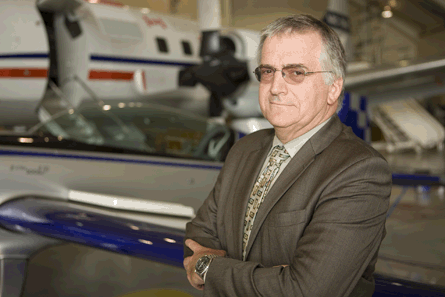Jerzy Komorowski is director general of the National Research Council (NRC), Canada's Institute for Aerospace Research.
Where can the NRC be found at the show?
We're part of the Canadian pavilion - we have been for a number of years and usually share our booth with an organisation called Defence Research and Development Canada - they're part of the Department of National Defence. They are our close partners, but we are part of a completely separate organisation.
Sometimes we call ourselves NRC Aerospace because my task is to pull as much of NRC into the aerospace sector as possible.
What is the focus of your presence at the show?
To give some examples of the things we are pitching. We're building a programme in aircraft cabin environments, and that's a happy marriage of our aerospace experience and expertise with our colleagues from the NRC Institute for Research in Construction, who have built a strong programme in interior environments.
As aircraft start to look more and more like flying buildings, the concerns for the quality of air, noise, vibration, and lighting are quite similar to the issues we are concerned with in buildings. Off-gassing from new materials has an impact on air quality, and we are trying to filter the air frequently enough to prevent any pathogens from circulating in the cabin, so this is a new, exciting programme we're building.
 |
|---|
© NRC |
Another one that also bridges to the other parts of NRC - we are about 10% of NRC, which employs around 4,300 people across Canada - is our very exciting biofuels programme.
We have the Institute of Marine Biosciences in Halifax that is strong in growing different types of algae, and we also have a Plant Biotechnology Institute in Saskatchewan, where they are very experienced in gene twisting and growing things like camelina, so that we can look both at plant and algae-derived oils as a source for new aviation fuels.
These are exciting programmes, but the reason we are in Farnborough is that it's one place where in a very short period of time you can meet a lot of your partners and clients.
Because the institute's clients are global, we have very strong relations with the Canadian, North American, European and Asian companies and organisations. There are similar organisations to ours in most aviation countries and this is where we meet them.
We expect to sign a few memorandums of understanding to solidify strategic engagements we have with these organisations.
It's quite interesting that Farnborough is a great place for me, not only to meet Europeans and partners from overseas, but it's also a wonderful place to meet all the Canadians in a very condensed period of time.
In fact, we surprisingly do a lot of business with Canadian companies as well, which is maybe counter-intuitive, but the Farnborough air show is a great place to get together to renew relationships and do a lot of business in a very intense way.
When will we see some of these technologies implemented in real aircraft?
These are changes that could be made to the fundamental design of the interior - of course, that's harder to bring changes to, but there are some incremental improvements, like better filters, better ways of treating the air, that can be brought in later on in life, so I think some impacts could be felt in the near term.
I think what we're looking at more is the impact of what we do in aircraft. It's easy to say we are going to measure the quality of air, but once you put people there, and galleys, and we start serving drinks and people are coughing, the whole environment changes and it's very important to be able to make measurements of that whole reality - that's the ambition we have.
How does your presence at this year's show compare with two years ago?
In some ways it is similar, but I think this time we are definitely going to expand our offer because of this connection we've made outside the institute.
I've given you two examples of how we represent a wider breadth of offerings to the aerospace industry than we did two years ago - when our programme, focusing on aerospace as a key sector in Canada, was very young.
How important is it to be able to turn your expertise into revenue-generating opportunities?
We are publicly funded, but when you look at the ratio of our income to expenditure, we are at about 55%. That means in real dollar numbers we have to generate about $30 million worth of aerospace research income from outside the NRC budget, which is significant and, of course, it changes our behaviour. That's why we have to be at Farnborough, because we have to be close to our clients and partners. They have to know about our capabilities and we have to be close and know what their needs are. That's really where it comes from.
The institute itself operates engine test cells, combustion cells and windtunnels and, to keep those running, we are also supporting other industries - automotive and construction in the case of windtunnels, and the energy industry in the case of gas turbines. We have a little bit of activity in those just to keep our equipment running.
Source: Flight Daily News























